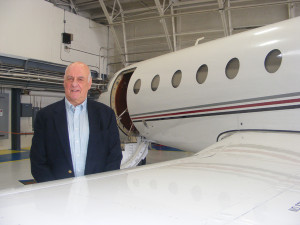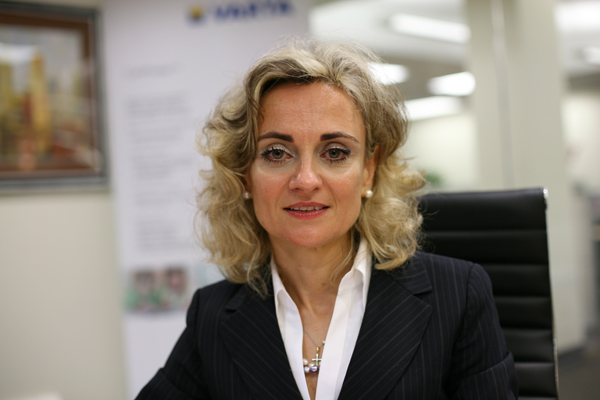Susan Cotten had timely news she readily shared with visitors to her organization”™s booth at this month”™s regional forum of the National Business Aviation Association at the Westchester County Airport.
“We”™ve flown 43,000 patients,” she said. “We just hit 43,000 this week.” The flyer was a cancer patient with non-Hodgkin”™s lymphoma for whom Cotten”™s nonprofit employer arranged to hitch a ride on a corporate jet flying from the Los Angeles area to the Boston area.

A former flight attendant for American Express Co., Cotten still is a frequent domestic flyer in her current job as patient transport development manager for Corporate Angel Network (CAN). On her stops, she visits hospitals to inform staff social workers and oncology nurses of the charitable service that CAN provides in arranging free flights for cancer patients aboard company jets with a seat or two to spare on their scheduled business routes. While in town, she also contacts the flight departments of companies to enlist their participation in a shared mission of medical philanthropy.
It”™s a transcontinental mission grounded and founded at the county airport in Westchester. Despite the turbulence of a recession and prolonged economic downturn and an accompanying storm of negative publicity over CEOs traveling in high-priced corporate jets, 652 companies have climbed aboard with CAN, the most in the network”™s 32-year history.
Bonnie LeVar, communications director at CAN, knows intimately that history. Her father, the late Leonard M. Greene, was one of three founders of the Corporate Angel Network. Safe Flight Instrument Corp. the company Greene launched in 1946 from his Yonkers apartment, has long been headquartered at 20 New King St. outside the county airport. LeVar”™s brother, Randall Greene, chairs the CAN board and succeeded their father as chairman, president and CEO of Safe Flight.
The corporate hitchhiking network was the inspiration of Priscilla “Pat” Blum, a Greenwich, Conn., resident and CAN”™s last surviving founder. A commercially licensed pilot, Blum flew recreationally out of the Westchester County Airport.
Blum in the early 1980s was a breast cancer survivor who had become involved with the work of the American Cancer Society. There she heard of the difficulties that cancer patients faced in arranging and paying for air travel to and from their treatment centers.
At the county airport one day, Blum watched as a nearly empty corporate plane dropped off a single passenger. “She thought, wow, wouldn”™t it be great if we could hitch a ride off of it” for cancer patients, said LeVar.
Blum brought her idea to Greene and another Westchester businessman, Jay N. Weinberg, the owner of an Avis Car Rental franchise in Mount Vernon. Greene had lost his wife to ovarian cancer and Weinberg had battled melanoma, and both were receptive. Greene, who had started his own charitable foundation, turned over its tax identification number to the startup network.
On Dec. 22, 1981, Greene piloted CAN”™s first flight, delivering a patient home for Christmas in Detroit after treatment at Memorial Sloan-Kettering in New York.
In its first full year of operation, CAN arranged 24 flights and had recruited 70 companies willing to take on a passenger without charge on the companies”™ regularly scheduled flights. By 1991, the charitable network had grown to include 509 companies that carried more than 4,400 patients.
“These companies do this out of the goodness of their heart,” said Peter Fleiss, a former consultant to Safe Flight Instrument and CAN”™s executive director since 2000, when the network flew its 15,000th patient.
With a marketing campaign driven by pro bono ads in large-circulation publications, Fleiss has accelerated the network”™s growth in his tenure. He heads a staff of seven full- and part-time employees and some 30 to 35 volunteers at CAN”™s headquarters at 1 Loop Road at the edge of the county airport. The landlord, Westchester County, provides the office space rent-free.
For participating companies, which include Purchase-based PepsiCo Inc. and half of the nation”™s Fortune 100 companies, “There”™s no tax benefit” from taking on a hitchhiker, said Fleiss. Many prefer to fly under the radar of public awareness of their aid to patients being treated or in clinical drug trials at about 100 cancer centers around the country.
“They don”™t want to promote their charity,” said Fleiss, “because of the perceptions about corporate jets” as fuel-guzzling, revenue-burning luxuries of fat-cat executives. “Companies don”™t want to publicize that they have corporate jets.”
That criticism from the press and public was especially virulent in the recession and federal bailout of U.S. automakers and too-big-to-fail banks in 2008.
“It clobbered the aviation industry,” Fleiss said of the recession. Manufacturers of corporate jets “had to lay off lots of employees… Corporations, some went under, some merged, some got rid of their airplanes.” In the credit crisis, some medium-sized companies were unable to obtain loans to acquire or replace a business aircraft, he said.
“Since 2008, we”™ve lost a lot of companies” from the network, said Fleiss. “But we”™ve gained more than we lost.”
With corporations cutting costs in the new economy, LeVar said, “It”™s harder to get flights for us now because the flights are definitely going fuller.”
Fleiss said CAN successfully schedules flights for about 250 patients each month. Yet it receives about 500 requests a month.“We still need a lot more to fly the other 250,” he said.
“We need more lift,” said LeVar. “We need more flights.”
“It”™s a numbers game,” said Fleiss, “and the more companies you have, the more routes you have, and as a result, the more people we can help,”
“We need more volunteers” to help with scheduling, calls to corporations, soliciting pro bono ads and other office tasks, said Fleiss.
There are no income limits for patients served by CAN. “My father never wanted to be a banker,” said LeVar. “They never believed in checking finances.
“I think it”™s great that it”™s such a good idea that it stood the test of time,” she said.



















